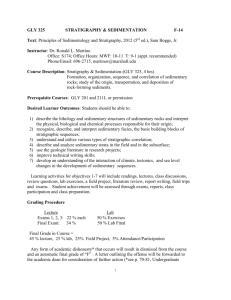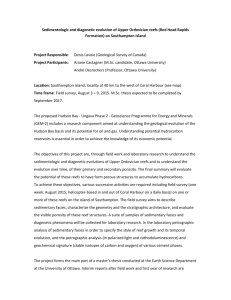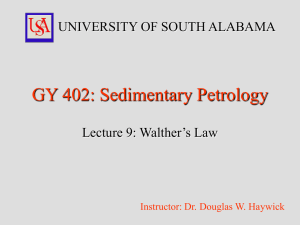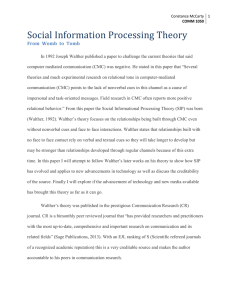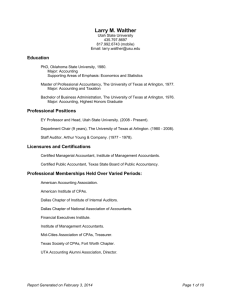Interpreting Sedimentary Environments and Global Change
advertisement
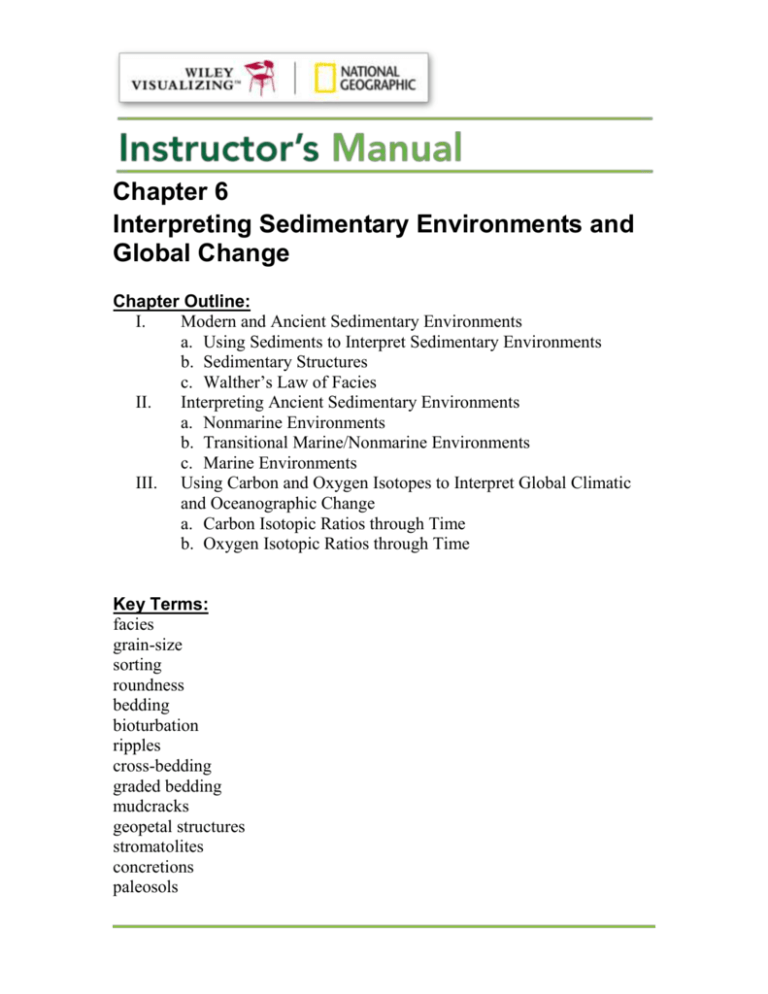
Chapter 6 Interpreting Sedimentary Environments and Global Change Chapter Outline: I. Modern and Ancient Sedimentary Environments a. Using Sediments to Interpret Sedimentary Environments b. Sedimentary Structures c. Walther’s Law of Facies II. Interpreting Ancient Sedimentary Environments a. Nonmarine Environments b. Transitional Marine/Nonmarine Environments c. Marine Environments III. Using Carbon and Oxygen Isotopes to Interpret Global Climatic and Oceanographic Change a. Carbon Isotopic Ratios through Time b. Oxygen Isotopic Ratios through Time Key Terms: facies grain-size sorting roundness bedding bioturbation ripples cross-bedding graded bedding mudcracks geopetal structures stromatolites concretions paleosols Walther’s Law of facies transgression continental shelf regression alluvial fans barrier island reef continental slope greenhouse gases In-Class Activities: Instructor Notes for In-Class Activity 1 Title: Sedimentary structures: Clues to past environmental conditions Time: 5-10 minutes prep; 50 – 60 minutes in class (or can assign research between class periods) Materials: Internet required. Print instruction sheets as handouts. Handouts: A list of questions for students to research and discuss using recommended websites. The textbook section called “Sedimentary Structures” is a useful reference for answering the handout questions. In addition to the textbook, the following websites are also useful references. http://www.geology.pitt.edu/GeoSites/sedstructures.htm http://people.uncw.edu/dockal/GLY312/sedstruct/sedstruct.htm http://facstaff.gpc.edu/~pgore/geology/historical_lab/sedstructureslab.php Have the students answer the following questions: Examine the following photo: http://www.geologyrocks.co.uk/system/files/u2/robinhoodsbay037.jpg 1) What type of sedimentary structure is depicted in the photo? 2) What inferences can a geologist make if he/she finds such structures in rocks (as it pertains to current direction)? Watch the following video and answer the following questions: http://www.youtube.com/watch?v=WUqldSl0jAI 3) How do conglomerates form in the shore zone? 4) Are these conglomerates formed in a low or high-energy environment? Why? 5) What types of sedimentary structures commonly form in beach environments? 6) Do beaches have structure? If they do, describe it. If they do not explain why. 7) What types of features and structures are produced by wind near beaches? Examine the following photo: http://www.geo.cornell.edu/geology/classes/geol326/images/modernmud.gif 8) What type of sedimentary structure is shown in the above photo, and what does it indicate about the environmental conditions during the time of deposition? Examine the following image: http://www.geology.ohio-state.edu/~vonfrese/gs100/lect11/xfig11_21.jpg 9) What type of sedimentary structure is depicted in the image? 10) Can this structure be used to determine stratigraphic up? Explain. Procedures: Divide class into groups of 3-4. Have the students read the section of the textbook called “Sedimentary Structures” in Ch. 6 of their textbook. In addition to this part of their textbook students can also use the following websites to answer the questions contained within this in-class exercise. http://www.geology.pitt.edu/GeoSites/sedstructures.htm http://people.uncw.edu/dockal/GLY312/sedstruct/sedstruct.htm http://facstaff.gpc.edu/~pgore/geology/historical_lab/sedstructureslab.php Have the students answer the 10 questions listed in the above handout section. The students should neatly write their answers down and hand them in to their instructor for grading. Knowledge of this information will be useful in preparing for both a future quiz and test. The goal of this in-class exercise is to study how geologists use sedimentary Student Instructions: structures to make inferences about the conditions that existed during the deposition process. Today, you will have the opportunity to see what these features look like, and how they form. Specific Suggestions: Objectives: At some later time during the semester, the instructor should provide the students with the opportunity to student sedimentary structures in the field. Students should become familiar with some of the common types of sedimentary structures and what they tell geologists about the environment of deposition for sedimentary rocks. Students should be able to recognize common sedimentary structures by sight (visually). Students should become familiar with some of the common indicators of stratigraphic up. In-Class Activity 1: Handout Read the textbook section called “Sedimentary Structures”. In addition to the textbook, the following websites are also useful references. http://www.geology.pitt.edu/GeoSites/sedstructures.htm http://people.uncw.edu/dockal/GLY312/sedstruct/sedstruct.htm http://facstaff.gpc.edu/~pgore/geology/historical_lab/sedstructureslab.php Answer the following questions as a group, write down your answers and submit them upon completion to your instructor for grading. By answering these questions you will be preparing for a future quiz and test. Examine the following photo: http://www.geologyrocks.co.uk/system/files/u2/robinhoodsbay037.jpg 1) What type of sedimentary structure is depicted in the photo? 2) What inferences can a geologist make if he/she finds such structures in rocks (as it pertains to current direction)? Watch the following video and answer the following questions: http://www.youtube.com/watch?v=WUqldSl0jAI 3) How do conglomerates form in the shore zone? 4) Are these conglomerates formed in a low or high-energy environment? Why? 5) What types of sedimentary structures commonly form in beach environments? 6) Do beaches have structure? If they do, describe it. If they do not explain why. 7) What types of features and structures are produced by wind near beaches? Examine the following photo: http://www.geo.cornell.edu/geology/classes/geol326/images/modernmud.gif 8) What type of sedimentary structure is shown in the above photo, and what does it indicate about the environmental conditions during the time of deposition? Examine the following image: http://www.geology.ohio-state.edu/~vonfrese/gs100/lect11/xfig11_21.jpg 9) What type of sedimentary structure is depicted in the image? 10) Can this structure be used to determine stratigraphic up? Explain. If time remains, have the students in your group discuss some of the other sedimentary structures that can be used to infer stratigraphic up. Instructor Notes for In-Class Activity 2 Title: Walther’s Law: A powerful tool for studying the lateral distribution of paleoenvironments Time: 5 – 10 Minutes prep; 40 – 60 minutes in class (or can assign research between class periods) Materials: Internet required. Print instruction sheets as handouts. Handouts: A list of websites and questions to be answered. Students will find Ch. 6 “Walther’s Law of Facies” to be useful in answering some of the questions. Also, students will find the following websites particularly useful: http://video.google.com/videosearch?q=walthers+law&hl=en&emb=0&aq=f# http://strata.geol.sc.edu/terminology/walther.html http://facstaff.gpc.edu/~pgore/geology/historical_lab/stratigraphy.php Procedures: Hand out instruction sheets. Instruct the students to use the websites listed above and Ch. 6 “Walther’s Law of Facies” in their textbook as references to answer the following questions: 1) Neatly draw a series of pictures to show how facies shift vertically with a sea-level drop (regression). Is a coarsening upward or a fining upward sequence produced? 2) Now draw a series of pictures to show what happens to these facies with a sea-level rise (transgression). Is a coarsening upward or a fining upward sequence produced? 3) What effect would unconformities have on Walther’s Law? Why? 4) Would dune facies migrate towards the onshore or offshore during a transgression? Explain. 5) How might Walther’s Law be used to determine whether global warming or cooling was occurring in the past? Student Instructions: See above Specific Suggestions: Objectives: The instructor should emphasize that a future lab quiz and lecture exam will contain questions to test the students understanding of Walther’s Law. The student should be able to show how Walther’s Law works by drawing detailed diagrams. Students should become familiar with the way facies shift with transgressions and regressions. Students should become aware of how Walther’s Law might be useful in studying past climate change. In-Class Activity 2: Handout Walther's Law of Facies, named after the geologist Johannes Walther, states that the vertical succession of facies reflects lateral changes in environment. It also states that when a depositional environment "migrates" laterally, sediments of one depositional environment come to lie on top of another. A classic example of this law is the vertical stratigraphic succession that typifies marine trangressions and regressions. However, the law is not applicable where the contact between different lithologies is non-conformable (i.e. sedimentation was not continuous), or in instances of rapid environmental change where non-adjacent environments may replace one another. The purpose of today’s in-class exercise is to familiarize you with Walther’s Law. Use the section on “Walther’s Law” in your textbook as a reference. Then watch the following video with the rest of your group. http://video.google.com/videosearch?q=walthers+law&hl=en&emb=0&aq=f# The following two websites should also be useful as reference in answering the below questions. http://strata.geol.sc.edu/terminology/walther.html http://facstaff.gpc.edu/~pgore/geology/historical_lab/stratigraphy.php Use a pencil to complete the following (since you will be making detailed drawings, and may need to do some erasing). 1) Neatly draw a series of pictures to show how facies shift vertically with a sealevel drop (regression). Is a coarsening upward or a fining upward sequence produced? 2) Now draw a series of pictures to show what happens to these facies with a sealevel rise (transgression). Is a coarsening upward or a fining upward sequence produced? 3) What effect would unconformities have on Walther’s Law? Why? 4) Would dune facies migrate towards the onshore or offshore during a transgression? Explain. 5) How might Walther’s Law be used to determine whether global warming or cooling was occurring in the past? By completing this in-class exercise you will be preparing for a future lab quiz and lecture exam.




